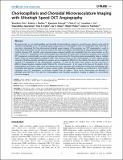Choriocapillaris and Choroidal Microvasculature Imaging with Ultrahigh Speed OCT Angiography
Author(s)
Jayaraman, Vijaysekhar; Cable, Alex E.; Duker, Jay S.; Huber, Robert; Fujimoto, James G.; Choi, Woo Jhon; Mohler, Kathrin Juliane; Potsaid, Benjamin M.; Lu, Chen David; Liu, Jonathan Jaoshin; ... Show more Show less
DownloadChoi-2013-Choriocapillaris and.pdf (5.059Mb)
PUBLISHER_CC
Publisher with Creative Commons License
Creative Commons Attribution
Terms of use
Metadata
Show full item recordAbstract
We demonstrate in vivo choriocapillaris and choroidal microvasculature imaging in normal human subjects using optical coherence tomography (OCT). An ultrahigh speed swept source OCT prototype at 1060 nm wavelengths with a 400 kHz A-scan rate is developed for three-dimensional ultrahigh speed imaging of the posterior eye. OCT angiography is used to image three-dimensional vascular structure without the need for exogenous fluorophores by detecting erythrocyte motion contrast between OCT intensity cross-sectional images acquired rapidly and repeatedly from the same location on the retina. En face OCT angiograms of the choriocapillaris and choroidal vasculature are visualized by acquiring cross-sectional OCT angiograms volumetrically via raster scanning and segmenting the three-dimensional angiographic data at multiple depths below the retinal pigment epithelium (RPE). Fine microvasculature of the choriocapillaris, as well as tightly packed networks of feeding arterioles and draining venules, can be visualized at different en face depths. Panoramic ultra-wide field stitched OCT angiograms of the choriocapillaris spanning ~32 mm on the retina show distinct vascular structures at different fundus locations. Isolated smaller fields at the central fovea and ~6 mm nasal to the fovea at the depths of the choriocapillaris and Sattler's layer show vasculature structures consistent with established architectural morphology from histological and electron micrograph corrosion casting studies. Choriocapillaris imaging was performed in eight healthy volunteers with OCT angiograms successfully acquired from all subjects. These results demonstrate the feasibility of ultrahigh speed OCT for in vivo dye-free choriocapillaris and choroidal vasculature imaging, in addition to conventional structural imaging.
Date issued
2013-12Department
Massachusetts Institute of Technology. Department of Electrical Engineering and Computer Science; Massachusetts Institute of Technology. Research Laboratory of ElectronicsJournal
PLoS ONE
Publisher
Public Library of Science
Citation
Choi, WooJhon, Kathrin J. Mohler, Benjamin Potsaid, Chen D. Lu, Jonathan J. Liu, Vijaysekhar Jayaraman, Alex E. Cable, Jay S. Duker, Robert Huber, and James G. Fujimoto. “Choriocapillaris and Choroidal Microvasculature Imaging with Ultrahigh Speed OCT Angiography.” Edited by Andreas Wedrich. PLoS ONE 8, no. 12 (December 11, 2013): e81499.
Version: Final published version
ISSN
1932-6203